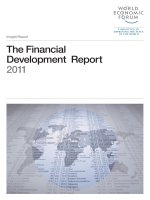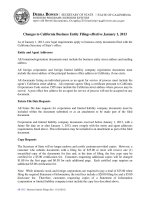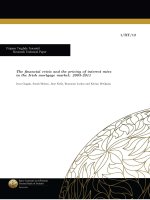Business valuation x431 9 jan mar 2011 PPT
Bạn đang xem bản rút gọn của tài liệu. Xem và tải ngay bản đầy đủ của tài liệu tại đây (8.34 MB, 183 trang )
Business Valuation
UC Berkeley Extension
UC Berkeley Extension
X431.9
X431.9
Bob Coackley
Bob Coackley
Introductions
Class is a 6.30 pm each Wednesday.
Class is a 6.30 pm each Wednesday.
Please be on time.
Please be on time.
All out-of-class exercises are to be in by
All out-of-class exercises are to be in by
the following class date.
the following class date.
If you are going to miss a class, please
If you are going to miss a class, please
send an e-mail to
send an e-mail to
Class info is on Yahoo Groups at:
Class info is on Yahoo Groups at:
http://
http://
finance.groups.yahoo.com/group/busval
finance.groups.yahoo.com/group/busval
/
/
Log in to
Log in to
join.
join.
Where Has All The Money Gone
Possibly $Tr 3.6 losses in the banking system
Possibly $Tr 3.6 losses in the banking system
Losses for private/institutional investors in
Losses for private/institutional investors in
stocks/bonds
stocks/bonds
Loss of book value of GDP
Loss of book value of GDP
Who now has all this?
Who now has all this?
Business Valuation Applications
Mergers and LBO’s
Mergers and LBO’s
Investment analysis for undervalued stocks
Investment analysis for undervalued stocks
IPO pricing
IPO pricing
VC funding
VC funding
Stock repurchase timing
Stock repurchase timing
Value Based Management
Value Based Management
Accounting Review
Purpose of the 3 main Financial Reports
Purpose of the 3 main Financial Reports
Depreciation – Is it Real? Is it cash?
Depreciation – Is it Real? Is it cash?
Is the P&L the full story?
Is the P&L the full story?
What is Operating Profit?
What is Operating Profit?
What is EBIT?
What is EBIT?
What is EBITDA?
What is EBITDA?
What is NOPAT?
What is NOPAT?
NOPLAT
Net Operating Profit Less Adjusted Taxes
Net Operating Profit Less Adjusted Taxes
- the profits generated from a company’s core
- the profits generated from a company’s core
operations less the income taxes related to the
operations less the income taxes related to the
core operations.
core operations.
Economic Profit
EP= NOPLAT – Capital Charge
EP= NOPLAT – Capital Charge
We will expand on this concept and formula
We will expand on this concept and formula
later
later
Free Cash Flow
FCF –
FCF –
The total cash available for distribution to owners &
The total cash available for distribution to owners &
creditors after funding all worthwhile investment
creditors after funding all worthwhile investment
activities.
activities.
FCF = NOPLAT + NonCash Operating Expenses –
FCF = NOPLAT + NonCash Operating Expenses –
investments in Invested Capital.
investments in Invested Capital.
FCF Example
NOPLAT
NOPLAT
210
210
Depreciation
Depreciation
20
20
Gross Cash Flow
Gross Cash Flow
230
230
Decrease (Incr) in inventory
Decrease (Incr) in inventory
(25)
(25)
Increase (Decr) in AP
Increase (Decr) in AP
25
25
Capex
Capex
(70)
(70)
Gross Investment
Gross Investment
(70)
(70)
FCF
FCF
160
160
Discounted Cash Flow
Backbone of modern finance
Backbone of modern finance
Forecast relevant cash flows
Forecast relevant cash flows
Calculate a figure of merit
Calculate a figure of merit
Compare to company acceptance criteria
Compare to company acceptance criteria
Cf: Hewlett-Packard “Return Factor”
Cf: Hewlett-Packard “Return Factor”
‘
‘
$5 of Op Profit for $1 of R&D expense’
$5 of Op Profit for $1 of R&D expense’
Cash Flows for Container Loading Pier
$M
$M
0
0
1
1
2
2
3
3
4
4
5
5
6
6
7
7
8
8
9
9
10
10
Cash
Cash
Flow
Flow
($40)
($40)
7.5
7.5
7.5
7.5
7.5
7.5
7.5
7.5
7.5
7.5
7.5
7.5
7.5
7.5
7.5
7.5
7.5
7.5
17
17
Year
$40
$7.5
$17
1 2 3 4 5 6 7 8 9 10
Cash Flow Diagram
Time Value of Money
3 factors
3 factors
1) Inflation
1) Inflation
2) Certainty
2) Certainty
3) Opportunity Cost
3) Opportunity Cost
Compounding
Single Period Compounding
$1
1
F1
F1=$1+(10%)($1)
F1= $1.1
1 2
F2
F2 = $1.10+(10%)($1.10)
F2= $1(1+0.10)
2
F2=1.21
Discounting
Present Value of a Promise for the Future!
Present Value of a Promise for the Future!
What is the value of $1 promised in 12 months
What is the value of $1 promised in 12 months
time? (Interest rate – 10%)
time? (Interest rate – 10%)
Answer = $0.909
Answer = $0.909
Check - Invest $0.909 at 10% = $0.909+ .0909 = $1!
Check - Invest $0.909 at 10% = $0.909+ .0909 = $1!
Multiple Period Discounting
Use a Financial Calculator, or
Use a Financial Calculator, or
Use Tables (Present Value Table)
Use Tables (Present Value Table)
Note: when cash flows are the same each year,
Note: when cash flows are the same each year,
they are known as “annuities”
they are known as “annuities”
Net Present Value (NPV)
Use the cash flow from Container Loading Pier
Use the cash flow from Container Loading Pier
and calculate present value of future cash flows
and calculate present value of future cash flows
(= $49.75M) (at 10% discount rate).
(= $49.75M) (at 10% discount rate).
Investment = $40M
Investment = $40M
Conclusion is that the company grows wealth of
Conclusion is that the company grows wealth of
$9.75M by investing in the Pier.
$9.75M by investing in the Pier.
NPV is $9.75M
NPV is $9.75M
Benefit Cost Ratio (BCR)
A.k.a. “Profitability index”
A.k.a. “Profitability index”
BCR =
BCR =
Present Value of cash inflows
Present Value of cash inflows
Present Value of cash outflows
Present Value of cash outflows
Ex:
Ex:
Pier BCR = (49.75)/($40) = 1.24
Pier BCR = (49.75)/($40) = 1.24
Internal Rate of Return (IRR)
Find the interest rate where PV of cash inflows
Find the interest rate where PV of cash inflows
equals PV of cash outflows.
equals PV of cash outflows.
(in other words it’s the % for NPV=0)
(in other words it’s the % for NPV=0)
Used to compare investment opportunities in the
Used to compare investment opportunities in the
same company and compare the result with the
same company and compare the result with the
“opportunity rate”.
“opportunity rate”.
IRR for the Pier is ~ 15%
IRR for the Pier is ~ 15%
Sunk Cost
Sunk Cost – that part of an investment that has
Sunk Cost – that part of an investment that has
been dissipated (spent) and is not recoverable.
been dissipated (spent) and is not recoverable.
Sunk Cost should not be part of any subsequent
Sunk Cost should not be part of any subsequent
project comparisons for future investment.
project comparisons for future investment.
(example ; Bay Bridge).
(example ; Bay Bridge).
IRR of a Perpetuity
P = A/r
P = A/r
P = Present Value
P = Present Value
A = Annual Receipt
A = Annual Receipt
r = discount rate
r = discount rate
r = A/P
r = A/P
Example a stock that sells for $480 and pays
Example a stock that sells for $480 and pays
$50/yr forever has IRR = 50/480 = 10.8%
$50/yr forever has IRR = 50/480 = 10.8%
Perpetuity Growth Formula
PV = d
PV = d
r
- g
or
r
=
d
PV
+ g
Where
PV = present value
d = 1
st
yr dividend
g = period growth
r = discount rate
APR vs EAR!
APR – Annual Percentage Rate (even if
APR – Annual Percentage Rate (even if
compounding is applied over a shorter period.
compounding is applied over a shorter period.
(Quarterly, Monthly etc).
(Quarterly, Monthly etc).
EAR is the “Effective Annual Rate including the
EAR is the “Effective Annual Rate including the
effect of compounding.
effect of compounding.
Example 10% APR = 10.25% EAR if compounded
Example 10% APR = 10.25% EAR if compounded
every six months.
every six months.
HW #1
1. If the present value of $320 paid one year from now at date 1 is $290, what is the
1. If the present value of $320 paid one year from now at date 1 is $290, what is the
one-year discount factor?
one-year discount factor?
2. If the present value of $460 paid one year from now at date 1 is $430, what is the
2. If the present value of $460 paid one year from now at date 1 is $430, what is the
one-year discount rate?
one-year discount rate?
3. Consider a perpetuity that pays $60 a year each year with the first payment being a
3. Consider a perpetuity that pays $60 a year each year with the first payment being a
year from now. The discount rate is 8%. What is the PV of the perpetuity?
year from now. The discount rate is 8%. What is the PV of the perpetuity?
4. Consider the perpetuity in question 3 except now the first payment is
4. Consider the perpetuity in question 3 except now the first payment is
today rather than
today rather than
a year from now. What is the PV of
a year from now. What is the PV of
the perpetuity now?
the perpetuity now?
5. Consider a growing perpetuity that has an initial payment
5. Consider a growing perpetuity that has an initial payment
today of $100. After that the
today of $100. After that the
annual payment increases by 5% a year forever. The discount rate is 10%. What is the
annual payment increases by 5% a year forever. The discount rate is 10%. What is the
PV of the growing perpetuity?
PV of the growing perpetuity?
6. What is the formula for finding the value of a t-year growing annuity with growth rate
6. What is the formula for finding the value of a t-year growing annuity with growth rate
g with the first payment of C one period from now?
g with the first payment of C one period from now?
7. Joe Williams has just taken out a $190,000 mortgage at an interest rate of 7%. If the
7. Joe Williams has just taken out a $190,000 mortgage at an interest rate of 7%. If the
mortgage calls for 15 equal annual installments, what is the amount of each
mortgage calls for 15 equal annual installments, what is the amount of each
installment?
installment?
8. Suppose you have just won the lottery and must choose one of the following
8. Suppose you have just won the lottery and must choose one of the following
(guaranteed) payoffs. Which one would you choose? The interest rate is 7%;
(guaranteed) payoffs. Which one would you choose? The interest rate is 7%;
ignore tax consequences.
ignore tax consequences.
A. $100,000 paid today
A. $100,000 paid today
B. $140,000 paid five years from today
B. $140,000 paid five years from today
C. $50,000 paid one year from today and $68,000 paid four years from today
C. $50,000 paid one year from today and $68,000 paid four years from today
D. $14,000 paid per year for ten years, with the first year's payment made today
D. $14,000 paid per year for ten years, with the first year's payment made today
ROIC
Return on Invested Capital
Return on Invested Capital
ROIC =
ROIC =
NOPLAT
NOPLAT
Invested Capital
Invested Capital
Cost of Capital
WACC (Weighted Average Cost of Capital)
WACC (Weighted Average Cost of Capital)
Is the rate of return that investors expect to earn
Is the rate of return that investors expect to earn
from investing in the company and therefore is
from investing in the company and therefore is
the appropriate discount rate for the NPV of
the appropriate discount rate for the NPV of
future Free Cash Flows.
future Free Cash Flows.
Made up of weighted average of: after tax cost of
Made up of weighted average of: after tax cost of
debt + cost of equity
debt + cost of equity









